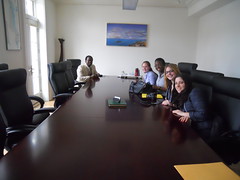
Dr. Abrokwaa and liberal arts undergraduates
prepare for the 2011 National Model African
Union Conference
Originally uploaded by LAUSatPSU
The National Model African Union is an annual conference held at Howard University in Washington D.C. at which students from across the country are invited to participate in a simulation of the real African Union and discussions about current issues facing Africa. The focus of the conference centers on intra-African relations and international affairs. The Model African Union gives students the opportunity to participate, as individuals and in teams, while conducting research on the political issues of a specific African nation. Each university is assigned a different country every year and this year, Penn State University was assigned to represent the interests of Malawi within the African Union.
As the Model AU’s Faculty Advisor and Trip Coordinator, Dr. Abrokwaa introduced me to the benefits of participating in the Model AU while I was enrolled in AAA S/HIST 192. After making the decision to attend the conference, I met with Dr. Abrokwaa to decide which committee would be right for me. Every student is assigned to a particular committee meant to maximize their educational experience. As I am an International Politics Major, Dr. Abrokwaa felt that it would be to my advantage to serve on the Technical Committee on Economic Matters. This would provide me with a chance to learn about Malawi’s role in the global market and how the latter affects international relations and foreign policy.
Following my committee assignment, I was ready to begin preliminary research about the current economy of Malawi. Guided by the Model AU’s Handbook, I learned how to create and format a formal resolution (just like the ones submitted in the actual African Union). Soon, I submitted a final copy to the Executive Council of the Model AU at Howard University.
Finally, February came around and we were ready for the conference. Shortly after we arrived in D.C., we headed to Embassy Row for our briefing at the Malawian Embassy. This briefing was designed to answer any questions or clarifications we had in order to best represent the interests of our assigned country. The briefing was definitely a highlight of the trip. Various members of the embassy were present at our meeting, including specialists in investments, agriculture, water and sanitation, communications, tourism, and gender equality.
The conference officially kicked off that evening at Howard University where we met the other students involved in the conference from across the United States. It was that evening that the council sessions began for the first time and we received copies of all submitted resolutions. The next morning we attended our day-long Executive Council and Ordinary Committee Sessions. Each committee worked on assigning resolutions to agenda topics; establishing the order of consideration for agenda topics; introducing and debating resolutions; adding amendments to resolutions; and finally, working together to pass resolutions. My fellow Malawian delegate in the Economic Committee and I worked alongside delegates from the African countries of Nigeria and Togo to merge our resolutions in order to create a single, more powerful resolution. This condensed resolution was eventually submitted to the secretariat for potential adoption. Sunday concluded the conference with the Assembly of Heads of State and Government. During this time, all submitted resolutions were voted on and adopted as final resolutions and certificates of recognition/participation were given out in the closing ceremony. In addition to my participation in the Model African Union, I also got to see a lot of Washington D.C. when the committees were out of session. It was a lot of fun to wander around D.C. and try some new restaurants.
In all, The Model AU helps students gain knowledge in various fields such as African studies, political science, international politics and relations, economics, social sciences, etc. More importantly, it shows participants that an understanding of African development is an important part in the comprehension of globalization in the 21st century. The Model AU allows participants to develop an understanding of current politics and economics of African countries and gives students a chance to represent the interests of a specific country. By understanding these individual needs, we can take important steps toward globalization.
I feel very fortunate that Dr. Abrokwaa chose me to participate in the National Model African Union conference. It is something that I wouldn’t have found out about otherwise, and I feel that I have gained exponentially from the experience. Not only have I gained knowledge and grown as an individual, but the Model African Union has also opened many opportunities for me to further my career goals. I would recommend that anyone interested in any of the areas mentioned above inquire about participation in the Model African Union.
If you are interested in participating in this opportunity there are a few more things you should know. First of all, it did not cost anything to participate in the Model AU this year. The conference was generously funded by various Penn State University organizations, offices and departments. Contributors included the Africana Research Center, the AAA S Department, the Liberal Arts Associate Dean’s Office, the Liberal Arts Minority Programs Office, and the Vice Provost for Educational Equity’s Office. You might also be wondering if participation in the conference is limited to AAA S majors or minors. That is not the case at all. Students in all majors are encouraged to participate. There are various committees (including committees focusing on government, economics, security, technology, etc.) within the Model AU, which cover areas in a variety of different majors in the College of the Liberal Arts.
For more information, visit the African & African American Studies Department website. In the meantime, take a look at some photos from the 2011 National Model African Union Conference.
